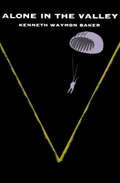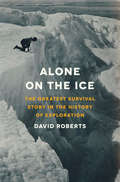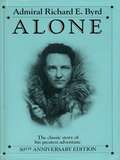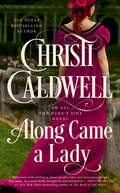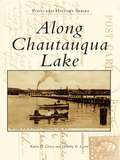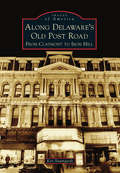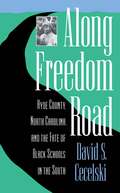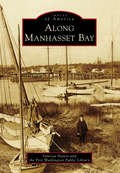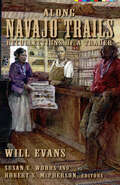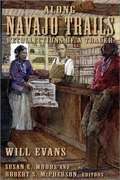- Table View
- List View
Alone in the Classroom
by Elizabeth HayIn a small prairie school in 1929, Connie Flood helps a backward student, Michael Graves, learn how to read. Observing them and darkening their lives is the principal, Parley Burns, whose strange behaviour culminates in an attack so disturbing its repercussions continue to the present day.Connie's niece, Anne, tells the story. Impelled by curiosity about her dynamic, adventurous aunt and her more conventional mother, she revisits Connie's past and her mother's broken childhood. In the process, she unravels the enigma of Parley Burns and the mysterious (and unrelated) deaths of two young girls. As the novel moves deeper into their lives, the triangle of principal, teacher, student opens out into other emotional triangles - aunt, niece, lover; mother, daughter, granddaughter - until a sudden, capsizing love thrusts Anne herself into a newly independent life. This spellbinding tale - set in Saskatchewan and the Ottawa Valley - crosses generations and cuts to the bone. It probes the roots of obsessive love and hate, how the hurts and desires of childhood persist and are passed on as if in the blood. It lays bare the urgency of discovering what we were never told about the past. And it celebrates the process of becoming who we are in a world full of startling connections that lie just out of sight.Following her award-winning, #1 bestselling Late Nights on Air, Alone in the Classroom is Elizabeth Hay's most intricate, compelling, and seductive novel yetFrom the Hardcover edition.
Alone in the Classroom
by Elizabeth HayHay is the winner of the prestigious Scotiabank Giller Prize, the Ottawa Book Prize, and the Libris Award for Fiction Book of the Year for her novel Late Nights on Air. Hay's fourth novel, Alone in The Classroom is a Globe and Mail Best Book. In a small prairie school in 1929, Connie Flood helps a struggling student, Michael Graves, learn how to read. Observing them and darkening their lives is the principal, Parley Burns, whose strange behavior culminates in an attack so disturbing its repercussions continue to the present day. Connie's niece, Anne, tells the story. Impelled by curiosity about her dynamic, adventurous aunt and her more conventional mother, she revisits Connie's past and her mother's broken childhood. In the process she unravels the enigma of Parley Burns and the mysterious, and unrelated, deaths of two young girls. As the novel moves deeper into their lives, the triangle of principal, teacher, student opens out into other emotional triangles--aunt, niece, lover; mother, daughter, granddaughter--until a sudden, capsizing love thrusts Anne herself into a newly independent life. This spellbinding tale--set in Saskatchewan and the Ottawa Valley--crosses generations and cuts to the bone. It probes the roots of obsessive love and hate, how the hurts and desires of childhood persist and are passed on, as if in the blood. It lays bare the urgency of discovering what we were never told about the past. And it celebrates the process of becoming who we are in a world full of startling connections that lie just out of sight. From the Hardcover edition.
Alone in the Classroom
by Elizabeth HayIn a small prairie school in 1929, Connie Flood helps a backward student, Michael Graves, learn how to read. Observing them and darkening their lives is the principal, Parley Burns, whose strange behaviour culminates in an attack so disturbing its repercussions continue to the present day. Connie's niece, Anne, tells the story. Impelled by curiosity about her dynamic, adventurous aunt and her more conventional mother, she revisits Connie's past and her mother's broken childhood. In the process she unravels the enigma of Parley Burns and the mysterious, and unrelated, deaths of two young girls.
Alone in the Classroom
by Elizabeth HayIn a small prairie school in 1929, Connie Flood helps a backward student, Michael Graves, learn how to read. Observing them and darkening their lives is the principal, Parley Burns, whose strange behaviour culminates in an attack so disturbing its repercussions continue to the present day. Connie's niece, Anne, tells the story. Impelled by curiosity about her dynamic, adventurous aunt and her more conventional mother, she revisits Connie's past and her mother's broken childhood. In the process she unravels the enigma of Parley Burns and the mysterious, and unrelated, deaths of two young girls.
Alone in the Valley
by Kenneth Waymon Baker&“This first novel by a disabled Vietnam veteran compassionately examines a year in the life of a combat infantryman during that conflict&” (Publishers Weekly). Alone in the Valley tells the story of nineteen-year-old Daniel Perdue and his year as a grunt, pursuing an elusive enemy through the steamy jungles of the Central Vietnamese Highlands. From the moment the boy solider touches down until he is airborne on his way home again, author Kenneth Waymon Baker makes sure the reader hears every sound, sees every sight, feels every emotion as his young hero faces the rigors of war. Daniel is changed forever, a man who will return with the instincts of a warrior. If you only read one book about Vietnam, make it Alone in the Valley. It will leave you touched and changed. &“A well-written and unassuming debut novel whose very artlessness is its principle virtue. Though his voice is unique, Baker tells it exactly as it was.&” —Kirkus Reviews
Alone in the Wild (The Oregon Trail)
by Jesse WileyIn this exciting choose-your-own-trail stand-alone experience featuring 8-bit art, it's 1849 and you are at the halfway point on your journey west on the Oregon Trail. When a powerful storm separates you from your family, you must use all of your smarts to survive on your own. Along the way, you meet a twelve-year-old girl from the Shoshone Nation, who has the grit and smarts to help you both make it to Oregon Territory. Which path will get you safely across the country and reunited with your family? With twenty-two possible endings, choose wrong and you'll never live out your dreams. Choose right and blaze a trail that gets you to Oregon City! Twitter: @oregontrail Facebook: facebook.com/oregontrail/
Alone on Guadalcanal
by Martin W. ClemensThis remarkable memoir tells the compelling story of the near-mythic British district officer who helped shape the first great Allied counteroffensive. Scottish-born and Cambridge-educated, Martin Clemens managed to survive months behind Japanese lines in one of the most unfriendly climates and terrains in the world. After countless partisan and spy missions, in 1942 he emerged from the jungle and integrated his Melanesian commando force into the heart of the 1st Marine Division's operations, earning the unfettered admiration of such legendary Marine officers as Vandegrift, Thomas, Twining, Edson, and Pate. The book is based on a journal Clemens kept during the war and might well be the last critical source of analysis of the Solomon's campaign. His eyewitness accounts of harrowing long-distance patrols and life on the run from shadowy Japanese intelligence operatives and treacherous islanders are unmatched in the literature of the Pacific War. First published in 1998, the story is essential and enjoyable reading.
Alone on the Ice: The Greatest Survival Story in the History of Exploration
by David Roberts"An important missing story from the heroic age of Antarctic exploration."--Laurence Gonzales, author of Deep Survival On January 17, 1913, alone and near starvation, Douglas Mawson, leader of the Australasian Antarctic Expedition, was hauling a sledge to get back to base camp. The dogs were gone. Now Mawson himself plunged through a snow bridge, dangling over an abyss by the sledge harness. A line of poetry gave him the will to haul himself back to the surface. Mawson was sometimes reduced to crawling, and one night he discovered that the soles of his feet had completely detached from the flesh beneath. On February 8, when he staggered back to base, his features unrecognizably skeletal, the first teammate to reach him blurted out, "Which one are you?" This thrilling and almost unbelievable account establishes Mawson in his rightful place as one of the greatest polar explorers and expedition leaders. It is illustrated by a trove of Frank Hurley's famous Antarctic photographs, many never before published in the United States.
Alone to Everest
by Earl DenmanThe story of some of Earl Denman’s mountaineering exploits to Africa, culminating in his journey in 1947 through Tibet to Everest with Tenzing Norgay (later to become one of the first two individuals known to reach the summit of Mount Everest) is here told for the first time.Alone to Everest tells the remarkable story of a remarkable man. Among many present-day accounts of hardship and adventure, it stands out as the testimony of a man for whom modern civilisation and modern equipment mean little, and who is happiest, as he says, “walking barefoot on warm grass or wet rocks; in probing deep into cool, quiet forests; in days of healthy activity and evenings of restfulness spent beside a warming fire.” Denman’s achievements in the Belgian Congo—where with only local guides as companions he became one of the first men to climb all eight of the high and remove Virunga Mountains—made him realise that he would never rest until he had made a similar expedition to the highest mountain in the world. At the time £250 was all he had in the world; his equipment was of the simplest and cheapest. His journey by sea and land to Darjeeling was made under great difficulties. His meeting with Karma Paul, who introduced him to Tenzing and his friend Ang Dowa, was entirely fortuitous; he was expressly forbidden to enter Tibet (Nepal at that time was entirely closed to the Western world). Yet with all these handicaps he and the two Sherpas set off alone from Darjeeling, made their way, with many mishaps, through Sikkim and Tibet to the Rongbuk monastery, and thence to Everest itself. Appalling weather conditions finally drove them back, but not before they had attained a height of 23,500 feet.Everest has now been climbed, and no doubt will be again. But Denman’s feat, though superficially unsuccessful, remains a triumph against fantastic odds.
Alone: Britain, Churchill, And Dunkirk: Defeat Into Victory
by Michael KordaCombining epic history with rich family stories, Michael Korda chronicles the outbreak of World War Two and the great events that led to Dunkirk. An epic of remarkable originality, Alone captures the heroism of World War II as movingly as any book in recent memory. Bringing to vivid life the world leaders, generals, and ordinary citizens who fought on both sides of the war, Michael Korda, the best-selling author of Clouds of Glory, chronicles the outbreak of hostilities, recalling as a prescient young boy the enveloping tension that defined pre-Blitz London, and then as a military historian the great events that would alter the course of the twentieth century. For indeed, May 1940 was a month like no other. The superior German war machine blazed into France, as the Maginot Line, supposedly "as firmly fixed in place as the Pyramids," crumbled in days. With the fall of Holland and Belgium, the imminent fall of Paris, the British Army stranded at Dunkirk, and Neville Chamberlain’s government in political freefall, Winston Churchill became prime minister on this historical nadir of May 10, 1941. Britain, diplomatically isolated, was suddenly the only nation with the courage and the resolve to defy Hitler. Against this vast historical canvas, Korda relates what happened and why. We first meet him at the age of six, surrounded by his glamorous movie family: his stage actress mother; his elegant father, Vincent, soon to receive an Academy Award; and his devoted Nanny Low, with whom he cites his evening prayers. Even the cheery BBC bulletins that Michael listened to every night could not mask the impending catastrophe, the German invasion so certain that the young boy, carrying his passport on a string around his neck, was evacuated to Canada on an ocean liner full of children. Such alarm was hardly exaggerated. No one, after all, could have ever imagined that the most unlikely flotilla of destroyers—Dutch barges, fishing boats, yachts, and even rowboats— would rescue over 300,000 men off the beach at Dunkirk and home to England. The miraculous return of the army was greeted with a renewed call for courage, and in the months that followed, the lives of tens of millions would be inexorably transformed, often tragically so, by these epochal weeks of May 1940. It is this pivotal turning point in world history that Korda captures with such immediacy in Alone, a work that triumphantly demonstrates that even the most calamitous defeats can become the most legendary victories.
Alone: The Classic Polar Adventure
by Richard E. ByrdWhen Admiral Richard E. Byrd set out on his second Antarctic expedition in 1934, he was already an international hero for having piloted the first flights over the North and South Poles. His plan for this latest adventure was to spend six months alone near the bottom of the world, gathering weather data and indulging his desire "to taste peace and quiet long enough to know how good they really are." But early on things went terribly wrong. Isolated in the pervasive polar night with no hope of release until spring, Byrd began suffering inexplicable symptoms of mental and physical illness. By the time he discovered that carbon monoxide from a defective stovepipe was poisoning him, Byrd was already engaged in a monumental struggle to save his life and preserve his sanity. When Alone was first published in 1938, it became an enormous bestseller. This edition keeps alive Byrd's unforgettable narrative for new generations of readers.
Along Alaska Trails: An Old Sourdough
by Lois McGarveyAlong Alaska Trails, first published in 1960, is the autobiographical account of Lois McGarvey (“An Old Sourdough”), who first traveled to Alaska in 1911. McGarvey, a young widow and mother at the time, would spend the rest of her life there, meeting success and failure along the way, but always maintaining a positive attitude, despite the many hardships she encountered along the way. From the Introduction: McGarvey “succeeded greatly in befriending people and enjoying life. Through her shrewdness and industry, she accumulated money in her later years. She cooked, mined, married, raised a family, sold furs, bought and sold real estate, kept a large boardinghouse for many different sorts of people—but no strangers—and one old blind man who was penniless but well fed and clothed because of her kindness. She came back from death's door five years ago, though she now has to use a wheelchair. Lois McGarvey knows tragedy, yet writes comedy for you.” Illustrated with 13 pages of photographs
Along Came a Duke
by Elizabeth Boyle"A young lady with a fortune is subject to all sorts of untoward attentions by the worst sort of vagrants." Aunt Allegra A lesson Tabitha Timmons, a penniless spinster, has never needed to heed. That is, until she is left a vast fortune payable only upon her marriage to the very respectable Mr. Barkworth-a match that offers little chance of discovering exactly what her aunt means by "untoward attentions." But the same can't be said when the Duke of Preston happens along Tabitha's path. He spies a rebellious streak in her that matches his own and he makes it his mission to save her from such a passionless match, interfering in her life at every turn. All too soon, Preston-whose very name spells ruin-has Tabitha caught between the good fortune that guarantees her security, and his kiss, which promises an entirely different kind of happily-ever-after.
Along Came a Lady (All the Duke's Sins #1)
by Christi CaldwellThe brooding, illegitimate son of a duke meets his match in the determined woman hired to transform him into a gentleman from USA Today bestselling author Christi Caldwell—perfect for fans of Bridgerton.Rafe Audley lives to thwart his father, the Duke of Bentley. The ne&’er do well who abandoned his children claims he wants to make up for his failures, but Rafe only cares about protecting the people of his mining community and providing for his three siblings, who've been his sole responsibility since childhood. So far, Rafe has turned away the duke's man of affairs, solicitor, and other interlopers, until the clever duke sends the unlikeliest of people to convince Rafe to join English High Society—a bold and intriguing woman. Edwina Dalrymple has never failed a charge. She's quite adept at successfully transforming young women of the gentry and daughters of newly minted lords to take their place in society. Taming a bastard son of a duke will be child's play, plus this job promises to enhance her reputation within the ton. All she has to do is fetch the wayward Rafe and groom him to be presentable to Polite Society. As the tenacious teacher and her domineering, stubborn, refuses-to-be-taught pupil engage in a fiery battle of wills, their chemistry ignites and the true lesson becomes clear: opposites attract and hearts must be heard.
Along Came a Rogue (The Secret Life of Scoundrels #2)
by Anna HarringtonTHE WICKEDEST SECRET . . .Major Nathaniel Grey is free to bed whomever he wants, whenever he chooses, and that's exactly how he likes it. His only loyalties are to country and the two friends he served with-brothers he'd do anything for. So when one of them is gravely injured and asking for his little sister, Grey will move heaven and earth to bring her home. He's greeted not by the gangly girl he remembers, but a stunningly beautiful woman holding a loaded musket. And he's utterly captivated by her . . . IS A SECRET SEDUCTIONOnce upon a time, Emily would have loved nothing more than a stolen hour with her brother's best friend, the dashing officer who captured her heart and soul. But things are different now-and so is she. Gone is the eager young woman who believed in love. In her place is a widow weighed down with secrets who desperately needs to disappear before they're revealed. But Grey's sinfully sexy smile offers protection unlike anything she's ever known, tempting her to risk everything . . . even her heart.
Along Chautauqua Lake (Postcard History Series)
by Dorothy E. Levin Karen E. LivseyShortly after settlement began along Chautauqua Lake, steamboats furnished transportation and the first hotel catered to visiting hunters and fishermen. Families escaping the summers in the city soon followed to enjoy the cool, healthy air. Chautauqua Institution and Point Chautauqua both began as religious assembly grounds. Celoron Park, often called the "Coney Island of the West," and later Midway Park provided entertainment for families and attracted thousands of visitors who traveled by trolley and steamboat in the summer. Local residents and visitors alike enjoyed the parks, picnic groves, and assorted resorts along the lake. A century later, fish are still caught, boats still ply the waters, and families continue to enjoy everything Chautauqua Lake has to offer.
Along Delaware's Old Post Road: From Claymont to Iron Hill
by Ken BaumgardtAlong Delaware's Old Post Road: From Claymont to Iron Hill snakes through the Colonial towns of Claymont, Wilmington, Newport, Stanton, Christiana, and the Pencader Hundred portion of northern Delaware. This 13-mile route has different names, from Philadelphia Pike to Maryland Avenue to Old Baltimore Pike, but it is along this road that the State of Delaware has its earliest roots. The photographs of the people and places are mostly misty memories as the route grew from a narrow dirt road to a modern four-lane thoroughfare. From Cooch's Bridge at one end, where the only battle on Delaware soil was fought, to Archmere Academy at the northern end, the corridor has a largely forgotten place in history. Travelers now trace the same route once traversed by George Washington, Thomas Jefferson, and Charles Mason and Jeremiah Dixon as they rode into history.
Along Different Lines: 70 Real Life Railway Stories
by Geoff Body Bill ParkerRunning a railway is a complex business. However well-run it is there will always be surprises, often hilarious, frequently unexpected, sometimes serious. Here railway professionals recall notable incidents from across their careers on the railways, lovingly compiled by expert railwaymen and authors Geoff Body and Bill Parker. The incidents covered in this illustrated book include such bizarre ‘everyday’ events as coping with hurricanes, rogue locomotives and runaway wagons, PR successes and otherwise, the Brighton Belle, Flying Scotsman and Mallard, training course capers, a wino invasion, trackside antics, the Eurostar backdrop, the birth of a prison, and royal and other special occasions. An enjoyable look back at life on the railways.
Along Freedom Road
by David S. CecelskiDavid Cecelski chronicles one of the most sustained and successful protests of the civil rights movement--the 1968-69 school boycott in Hyde County, North Carolina. For an entire year, the county's black citizens refused to send their children to school in protest of a desegregation plan that required closing two historically black schools in their remote coastal community. Parents and students held nonviolent protests daily for five months, marched twice on the state capitol in Raleigh, and drove the Ku Klux Klan out of the county in a massive gunfight. The threatened closing of Hyde County's black schools collided with a rich and vibrant educational heritage that had helped to sustain the black community since Reconstruction. As other southern school boards routinely closed black schools and displaced their educational leaders, Hyde County blacks began to fear that school desegregation was undermining--rather than enhancing--this legacy. This book, then, is the story of one county's extraordinary struggle for civil rights, but at the same time it explores the fight for civil rights in all of eastern North Carolina and the dismantling of black education throughout the South.
Along Iowa's Historic Highway 20
by Michael J. TillUS Highway 20 was designated a federal highway in 1926. For the first half of the 20th century, it was the most important east-west road across northern Iowa, extending from the Mississippi to the Missouri River. The road connected 13 counties, four major metropolitan areas, and many smaller communities along its route. Fortunately, the historic two-lane road remains almost completely intact and can be driven much as travelers did in years gone by. Along Iowa's Historic Highway 20 celebrates such a trip, illustrated by more than 200 antique postcards that show the personality of the road: town and city scenes, rural vistas, rivers, bridges, and historic sites. Not to be forgotten are the tourist courts, hotels, diners, and gas stations that made travel possible.
Along Lake Michigan: Shipwreck Stories of Life and Loss
by Michael SchumacherNotable shipwrecks of Lake Michigan throughout a century of enterprise, industry, heroism, and disaster on the Great Lakes The Great Lakes are graveyards of a vast number of shipwrecks (30,000 by some estimates), and Lake Michigan has more than the other four lakes combined. The stories of those wrecks tell the history of that mighty lake in its endless, mercurial challenge to human endeavor. Surveying the wreckage throughout the decades, from the fiery end of the twin propeller–driven Phoenix in 1847 to the failure of the Anna Minch to outrun the infamous 1940 Armistice Day storm, Michael Schumacher charts the course of shipping disasters great and small on Lake Michigan. He illuminates the details of maritime weather and shipcraft, the lives devoted to and lost on the water, and the mistakes and monumental failures that led to these ships&’ watery ends. Schumacher&’s deft storytelling, drawing from deep research and comprehensive knowledge, brings forth the vivid details of the last minutes of these doomed ships, along with the circumstances surrounding their voyages. Here are tragic tales like that of the Eastland, the deadliest shipwreck in Great Lakes history, lost while docked in the Chicago River; the Rouse Simmons, a wooden schooner loaded with Christmas trees; the train ferry Milwaukee and the Wisconsin, a package freighter, gone within one week of each other in October 1929; and the passenger vessel the Lady Elgin, a devastating loss met with incredible heroism. Liberally illustrated with historical photographs, the stories of these shipwrecks, spanning a full century of commercial traffic on Lake Michigan, document the myriad forms of bravery and misfortune that mark our encounters with the Great Lakes.
Along Manhasset Bay (Images of America)
by Port Washington Public Library Vanessa NastroThe waters of Manhasset Bay have long been an incubator for innovation and prosperity. While early baymen sought their livelihood through clam digging and fishing, a new industry by way of sand mining forever changed the bucolic hilltops that overlooked the bay. While the sand mining industry brought prosperity and notoriety, the industry's use of heavy machinery and hydraulic pumps leveled the peninsula, once known for its lush grazing pastures. During the early 1900s, areas such as Port Washington, Manhasset, and Great Neck flourished into commuter, suburban towns. Shifting from a farming to a suburban community, homes began to develop along Manhasset Bay. Urbanization brought new housing and businesses such as hotels and lavish restaurants. As an epicenter for aviation, the bay launched historic flights through a then-fledgling Pan American Airway Corporation on Manhasset Isle. Elite yacht clubs and grand estates dotted the shoreline, all catering to a growing population looking to the bay for its leisure and livelihood. The once-tranquil waters are now a hub for city vacationers, bustling commuters, and entrepreneurs.
Along Navajo Trails: Recollections of a Trader
by Will EvansA piece of Navajo history otherwise forgotten: the first-hand observations of a Mormon trader on the culture and art of his Navajo contemporariesThe overwhelming interest of Will Evans, proprietor of the Shiprock Trading Company, in Navajo culture spanned a half century. He shared his enthusiasm through frequent publication of portraits, vignettes, and essays; he also compiled much of his writing into a book manuscript. His subjects were his customers, friends, and neighbors, their stories of historic events such as the Long Walk, and their life as he understood it. Evans&’s writings were colored by his uncommon friendship and familiarity with Navajo people but also by who he was: a trader, folk artist, and Mormon. Inspired by sand paintings, Evans appropriated their sacred images for his own paintings of murals and everyday objects. In his writing, he preserved unique records of Navajo history and of individuals about whom little biographical information otherwise remains. Much of that was based on what he heard from his Navajo acquaintances, but it also drew on his direct observations and particular beliefs about the people, their culture, and their history. Evans&’s granddaughter Susan E. Woods collaborated with historian Robert S. McPherson, author of numerous books on Navajo and Four Corners history, to prepare and publish Will Evans&’s manuscript, which is illustrated with a remarkable and rare selection of photos from the collections of Evans and his colleagues.
Along Navajo Trails: Recollections of a Trader, 1898-1948
by Will EvansWill Evans's writings should find a special niche in the small but significant body of literature from and about traders to the Navajos. Evans was the proprietor of the Shiprock Trading Company. Probably more than most of his fellow traders, he had a strong interest in Navajo culture. The effort he made to record and share what he learned certainly was unusual. He published in the Farmington and New Mexico newspapers and other periodicals, compiling many of his pieces into a book manuscript. His subjects were Navajos he knew and traded with, their stories of historic events such as the Long Walk, and descriptions of their culture as he, an outsider without academic training, understood it. Evans's writings were colored by his fondness for, uncommon access to, and friendships with Navajos, and by who he was: a trader, folk artist, and Mormon. He accurately portrayed the operations of a trading post and knew both the material and artistic value of Navajo crafts. His art was mainly inspired by Navajo sandpainting. He appropriated and, no doubt, sometimes misappropriated that sacred art to paint surfaces and objects of all kinds. As a Mormon, he had particular views of who the Navajos were and what they believed and was representative of a large class of often-overlooked traders. Much of the Navajo trade in the Four Corners region and farther west was operated by Mormons. They had a significant historical role as intermediaries, or brokers, between Native and European American peoples in this part of the West. Well connected at the center of that world, Evans was a good spokesperson.
Along New York's Route 20 (Postcard History Series)
by Michael J. TillFew roads can match Route 20's beauty, history, or contribution to New York's vitality. In 1926, Route 20 became a federal highway and evolved into New York's foremost east-west road. But unlike most early highways, it has survived almost completely intact. The story of Route 20 is told through more than 200 vintage postcards showing scenes from the Shaker communities in Columbia County to the Lake Erie Shore. The postcards show the personality of the road: main streets, the Finger Lakes, and scenic vistas. Not to be forgotten are the tourist courts, hotels, diners, and gas stations that made travel possible.



